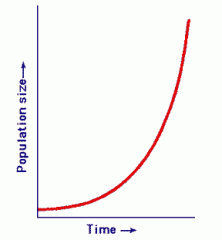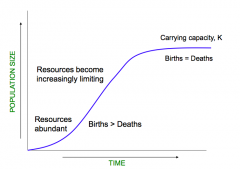![]()
![]()
![]()
Use LEFT and RIGHT arrow keys to navigate between flashcards;
Use UP and DOWN arrow keys to flip the card;
H to show hint;
A reads text to speech;
13 Cards in this Set
- Front
- Back
|
four general processes that regulate a population |
births, immigration, deaths, emigration |
|
|
exponential growth curve |

b>d larger pop. gets, more individuals there are to reproduce
|
|
|
logistic growth curve |

population size is limited by carrying capacity, k, due to limiting factors |
|
|
environmental resistance to population growth |
• Light, nutrient and water supply• Competition for space• Predation• Disturbance frequency and intensity |
|
|
does carrying capacity remain same? |
No, weather effects for example |
|
|
factors that determine how fast a population can potentially grow? |
1. Age of first reproduction2. Frequency of reproduction3. Ave. number offspring produced4. Length of reproductive lifespan5. Death Rate |
|
|
density independent |
limiting factors unaffected by pop. size, disturbances, non-infectious disease |
|
|
density dependent factors |
disease, predation, competition |
|
|
3 ways pop. can be arranged |
clumped, uniform, random-environmental conditions |
|
|
r strategy |
RRRapid growth, small bod, single rep. event, weedy&early succession species |
|
|
k strategy |
slow growth, few offspring, large bod, late succession & perennial |
|
|
four characteristics of populations: |
Size: number of individuals making up its genepool Density: Number of individuals per unit of area(e.g., 20/hectare) Age Structure: relative proportions ofindividuals of each age Distribution: Pattern in which individuals aredispersed in a specific area |
|
|
examining age class of trees useful |
for determining pop. growth in future |

